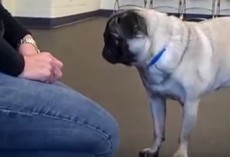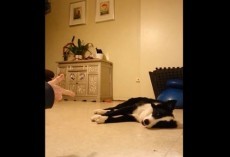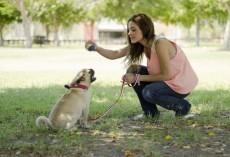If you have some dog lovers in your family then you should feel excited that you get to put them to work. You'll need a few friends and/or family members that don't know your pup very well but are willing to help her overcome her shyness.
Supply your volunteers with your Pug's favorite treats — this will hopefully help her overcome her nervousness more quickly! Now it's time to help her become a social pup with the below tips:
Shyness and timidity can develop as a young dog matures. Sometimes the root of the problem is lack of proper introduction to different people, animals, places and things during the prime puppyhood socialization period. Other causes include emotional trauma, physical abuse or simply not getting enough social interaction. Shyness and fear are problematic traits that can lead to aggression and biting.
Owners can help their dogs mature into confident, stable dogs by carefully but consistently introducing the pets to other people, other friendly dogs and new environments outside the home. Daily walks on leash are often the most practical way to do this.
Set up a situation for learning new, positive responses:
If you have a more mature dog who is shy, help the dog gradually gain confidence.Have your helper avoid eye contact with the dog, stay quiet and still, stand sideways to the dog, and keep at an ample distance from the dog. Let the dog initiate contact and approach when he feels ready.
The helper can crouch down or sit on the floor, maintaining the nonthreatening sideways stance, with eyes still averted. Have the helper extend a hand in the direction of the dog and drop a treat. Eventually the dog will sniff around and slowly approach.
The owner has a role to play during these exercises. Project a happy, relaxed body posture and tone of voice. Make it clear that you welcome the helper's presence. You want your dog to get the clue that during these practice sessions, your helper is the only source for treats and positive interaction.
Eventually, the dog will show signs of budding confidence. Ideally, the dog will touch the helper's hand upon taking the treat. The helper can softly say, “Good dog”. Eventually make eye contact. However, progress slowly to avoid the setback of a fear response.
It might take a few of these set-up encounters for the dog to feel comfortable enough to approach at all. So be patient. The results will be worth it.
As the dog gains confidence, repeat the practice sessions in other rooms and then outside of the home, and with different helpers of varying ages, sizes, and gender.
Is your dog shy around someone in the home, or certain types of individuals?If your dog is shy around men, for example, have a man prepare and set down the dog's meal. If the dog is fearful of someone in the family, consider the possible reasons.
If it seems the dog's fear relates to the size or gender or physical traits of the person, work daily on desensitizing the dog to the person, and counter-conditioning, so that the dog learns to associate POSITIVE experiences with men/big people/people in wheelchairs etc.
Here's one technique for building a bond between the dog and a person he fears in the household: let that person be the one to feed, walk and eventually play with the dog.
If you are the preferred person, and your dog clings to you, ignore him. He will realize that if he wants to eat or play, he must interact with the “other” person.
This person should not impose his or her will on the dog. And at the beginning, he should avoid eye contact with the dog.
If you are the dog's preferred person, you may find it hard to withhold attention and affection.
Remember to praise and give rewards (which can be yummy treats or a very favorite toy) for even the tiniest signs of progress.
Is your dog shy around other dogs?
Start off by introducing the shy dog to a smaller dog who you know to be friendly and relatively calm. As the dog begins to get comfortable, gradually introduce dogs of larger sizes and more active behavior.
Obedience training and agility classes:
Obedience training and agility training are excellent ways to help a dog feel more comfortable and confident in public and with other dogs and people. Just as it works with people, learning new skills improves the dog's outlook on life as well as self-confidence.
Another important training tip:
The shy or fearful dog can be frightened and even traumatized by forceful training methods. Today, the emphasis in the dog training world is positive, reward-based training, even for confident, untroubled pups and dogs.
Some ideas for playing with a shy dog:
- Here's a nonthreatening way to play with your shy dog: crawl around on the floor and roll over. This will get the dog's interest.
- When having guests at your home, you can have them sit on the floor. Instruct them to avoid any eye contact with your dog, and to refrain from talking to the dog. However, when the dog begins to approach your guests out of curiousity, have them nonchalantly turn their backs to the dog.
Some words about fear aggression:
- Often, fear aggression results from the dog feeling uncertain of the outcome of an interaction – fear of the unknown. Aggression is a panicked response stemming from loss of control. Ignorance leads to fear, and fear leads to aggression.
Ways to help prevent shyness … and help deal with shyness:
- Take your pup out with you when you run errands. Introduce the pup to as many people and dogs as possible, making sure you control the situation so that nothing happens to frighten the dog.
- Host a doggie party at your home. Invite only friendly pups and dogs.
- Teach your pup or dog obedience skills.
- Take your pup or dog on walks. Stay relaxed yourself.
- When your dog begins displaying more trust and staying calm during such close encounters, happily praise the dog and offer a treat. For the shy or fearful dog, however, use a calm vs. overly exuberant tone of voice.
Remember, do not force a dog to interact with a person or other canine.- Do not comfort and coddle your dog when he displays fear. Yes, protect him from potential and real threats, but do not reward his fear responses with attention and affection.
- All dogs need exercise every day. Among other benefits, exercise helps reduce canine stress and makes dogs happier – particularly important for the shy dog.
- Yawning serves as a “calming signal” for dogs. People can actually adapt this to work in communicating with their dogs.
- Establish a safe den in your home. While particularly important for the shy dog, even the most confident and stable dog may have reason to occasionally retreat to a private place. Before expecting your dog to realize that's his spot, take time to teach him by creating positive associations with his special den.
The overall theme with this article (that you can read in its entirety on Paw Rescue) is to stay in tune with your pup's body language and being very patient. The last thing you want to do is create more anxiety, so take it slow and allow your pooch to get used to social interactions on her own time. Soon enough you'll have a fur baby who is now thriving in social situations and it will be thanks to you and your great training!










